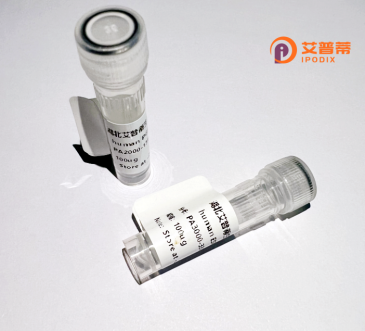
| 纯度 | >90%SDS-PAGE. |
| 种属 | Human |
| 靶点 | ARHGAP4 |
| Uniprot No | P98171 |
| 内毒素 | < 0.01EU/μg |
| 表达宿主 | E.coli |
| 表达区间 | 1-946aa |
| 氨基酸序列 | MAAHGKLRRERGLQAEYETQVKEMRWQLSEQLRCLELQGELRRELLQELAEFMRRRAEVELEYSRGLEKLAERFSSRGGRLGSSREHQSFRKEPSLLSPLHCWAVLLQHTRQQSRESAALSEVLAGPLAQRLSHIAEDVGRLVKKSRDLEQQLQDELLEVVSELQTAKKTYQAYHMESVNAEAKLREAERQEEKRAGRSVPTTTAGATEAGPLRKSSLKKGGRLVEKRQAKFMEHKLKCTKARNEYLLSLASVNAAVSNYYLHDVLDLMDCCDTGFHLALGQVLRSYTAAESRTQASQVQGLGSLEEAVEALDPPGDKAKVLEVHATVFCPPLRFDYHPHDGDEVAEICVEMELRDEILPRAQNIQSRLDRQTIETEEVNKTLKATLQALLEVVASDDGDVLDSFQTSPSTESLKSTSSDPGSRQAGRRRGQQQETETFYLTKLQEYLSGRSILAKLQAKHEKLQEALQRGDKEEQEVSWTQYTQRKFQKSRQPRPSSQYNQRLFGGDMEKFIQSSGQPVPLVVESCIRFINLNGLQHEGIFRVSGAQLRVSEIRDAFERGEDPLVEGCTAHDLDSVAGVLKLYFRSLEPPLFPPDLFGELLASSELEATAERVEHVSRLLWRLPAPVLVVLRYLFTFLNHLAQYSDENMMDPYNLAVCFGPTLLPVPAGQDPVALQGRVNQLVQTLIVQPDRVFPPLTSLPGPVYEKCMAPPSASCLGDAQLESLGADNEPELEAEMPAQEDDLEGVVEAVACFAYTGRTAQELSFRRGDVLRLHERASSDWWRGEHNGMRGLIPHKYITLPAGTEKQVVGAGLQTAGESGSSPEGLLASELVHRPEPCTSPEAMGPSGHRRRCLVPASPEQHVEVDKAVAQNMDSVFKELLGKTSVRQGLGPASTTSPSPGPRSPKAPPSSRLGRNKGFSRGPGAPASPSASHPQGLDTTPKPH |
| 分子量 | 105 kDa |
| 蛋白标签 | His tag N-Terminus |
| 缓冲液 | 冻干粉 |
| 稳定性 & 储存条件 | Lyophilized protein should be stored at ≤ -20°C, stable for one year after receipt. Reconstituted protein solution can be stored at 2-8°C for 2-7 days. Aliquots of reconstituted samples are stable at ≤ -20°C for 3 months. |
| 复溶 | Always centrifuge tubes before opening.Do not mix by vortex or pipetting. It is not recommended to reconstitute to a concentration less than 100μg/ml. Dissolve the lyophilized protein in distilled water. Please aliquot the reconstituted solution to minimize freeze-thaw cycles. |
以下为3-4条关于ARHGAP4的参考文献及摘要概括:
1. **"ARHGAP4 modulates X-linked intellectual disability through regulation of Rho GTPases"**
- **作者**:K. M. Myers et al.
- **摘要**:探讨ARHGAP4作为X染色体连锁基因在智力障碍中的作用,发现其通过调控RhoA/Cdc42活性影响神经元突触发育及认知功能。
2. **"ARHGAP4 promotes tumor cell invasion by regulating cytoskeletal dynamics in prostate cancer"**
- **作者**:T. Chen et al.
- **摘要**:研究ARHGAP4在前列腺癌细胞迁移和侵袭中的功能,揭示其通过抑制RhoA活性增强肌动蛋白重构,驱动肿瘤转移。
3. **"ARHGAP4 interacts with the XIST RNA and mediates escape from X chromosome inactivation"**
- **作者**:A. R. Dall et al.
- **摘要**:揭示ARHGAP4与XIST非编码RNA的相互作用,参与调控X染色体失活逃逸基因的表达,可能与性别差异性疾病相关。
4. **"Functional characterization of ARHGAP4 in acute myeloid leukemia progression"**
- **作者**:J. Li et al.
- **摘要**:发现ARHGAP4在急性髓系白血病(AML)中高表达,通过激活Rac1信号通路促进白血病细胞增殖和耐药性,提示其作为治疗靶点的潜力。
建议通过PubMed或Google Scholar搜索具体标题获取全文。
**Background of ARHGAP4**
ARHGAP4 (ADP-ribosylation factor GTPase-activating protein 4) is a member of the RhoGAP protein family, which regulates Rho GTPases—critical molecular switches controlling cytoskeletal dynamics, cell migration, and signal transduction. By enhancing the intrinsic GTP-hydrolysis activity of Rho GTPases, ARHGAP4 inactivates these proteins, thereby modulating their downstream effects. Structurally, ARHGAP4 contains a conserved RhoGAP domain responsible for GTPase interaction and catalytic activity, alongside a PH (pleckstrin homology) domain that may facilitate membrane association or protein interactions.
Functionally, ARHGAP4 has been implicated in diverse cellular processes, including cell adhesion, polarity, and vesicle trafficking. It shows specificity toward GTPases like RhoA and Cdc42. influencing actin remodeling and microtubule organization. Dysregulation of ARHGAP4 is linked to pathological conditions; for example, aberrant expression has been observed in certain cancers, potentially affecting tumor invasiveness and metastasis. Additionally, ARHGAP4 localizes to the X chromosome, raising interest in its role in X-linked disorders. Emerging studies suggest its involvement in immune responses and neuronal development, though mechanistic details remain under investigation.
Overall, ARHGAP4 serves as a key regulatory node in Rho GTPase signaling, with broad implications for cellular homeostasis and disease. Further research is needed to unravel its context-dependent roles and therapeutic potential.
×